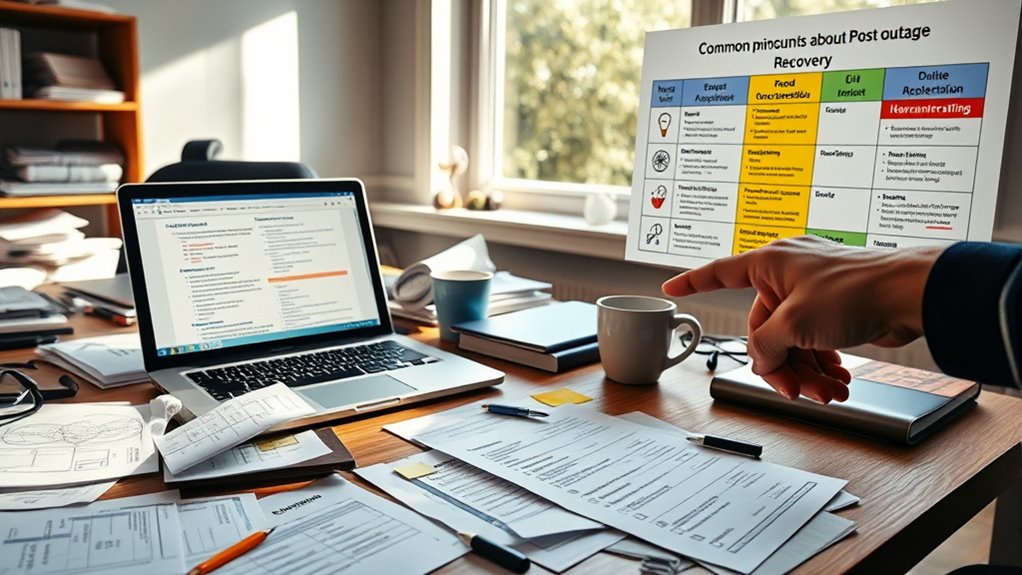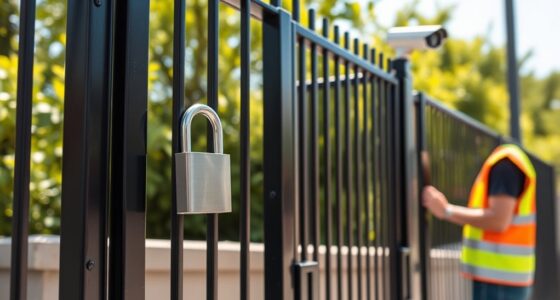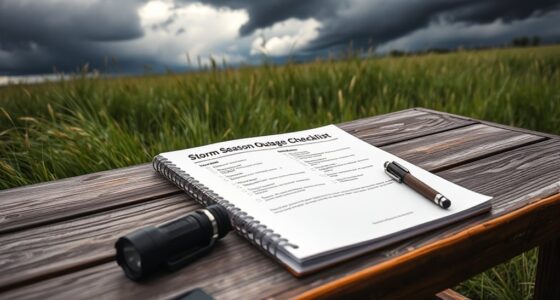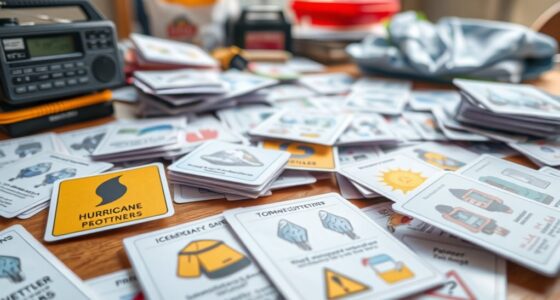After a power outage, many beginners believe power will come back quickly and safely, but that’s often not true. You might assume all equipment is safe instantly, neglect safety checks, or skip inspecting for structural damage and hazards. You could also forget to reset circuit breakers properly or overlook replenishing essential supplies. Believing that power means everything works and plans don’t need updating can cause bigger problems. Stay aware—there’s more to guarantee your recovery is safe and effective.
Key Takeaways
- Many assume power restoration means all systems are immediately functional, which can lead to skipped safety checks.
- Overlooking damage to electrical wiring and outlets increases fire and shock risks during recovery.
- Failing to verify safety and functionality of backup generators and security systems can cause further issues.
- Neglecting indoor ventilation and environmental hazards can cause mold growth and air quality problems post-outage.
- Inadequate food, water, and supply inventory management hampers recovery and preparedness for future outages.
Believing the Power Will Come Back Quickly and Without Precautions

Many people assume that power will be restored quickly after an outage, leading them to skip important precautions. This mindset can be dangerous, especially when it comes to generator safety. Running a generator improperly can cause carbon monoxide poisoning or electrical hazards. Before restoring power to your home, it’s vital to perform an electrical inspection to identify any damage or faulty wiring. Don’t assume everything is fine just because the lights haven’t come back on yet. Taking these steps ensures your safety and prevents further damage. Remember, rushing to turn appliances back on without proper precautions can be risky. Always wait for official signals that the power is stable, and inspect your electrical system thoroughly before reconnecting anything. Additionally, being aware of local store hours can help you plan your shopping trips efficiently once power is restored.
Ignoring Safety Before Restoring Power to Appliances and Devices
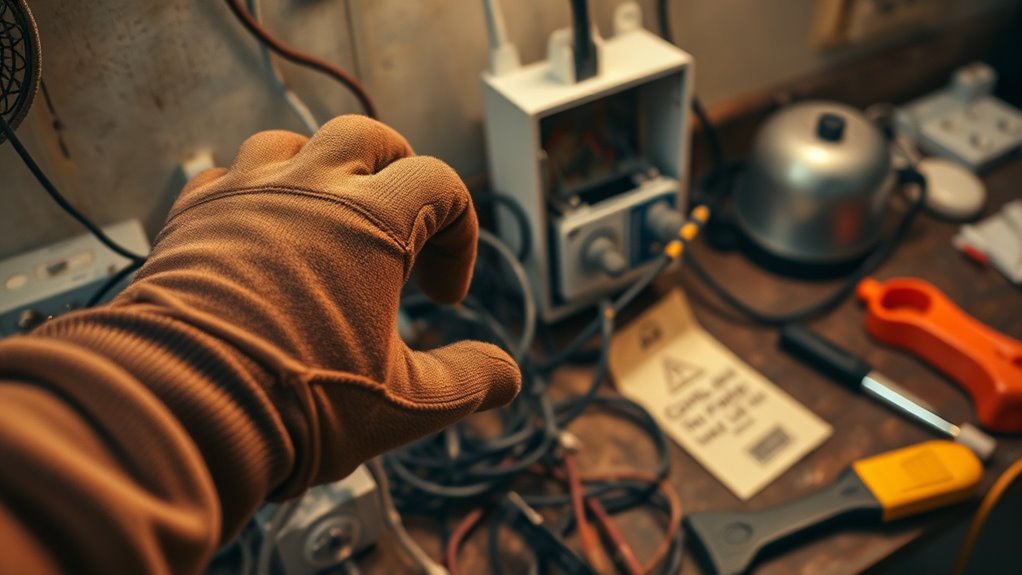
Before restoring power, you need to check that all equipment is safe to turn back on. Make sure no wires are damaged or exposed, and that appliances are in good condition. Always turn off the main power switch before reconnecting devices to prevent accidents or further damage. Additionally, inspecting for electrical safety hazards can help prevent potential injuries or electrical fires.
Verify Equipment Safety
Ensuring equipment safety is a critical step before restoring power to your appliances and devices, as damaged or compromised equipment can pose hazards once energized. Check your solar panels for cracks or corrosion that could cause electrical shorts. Inspect your generator for fuel leaks, frayed cords, or other signs of wear, emphasizing generator safety. Make sure all wiring connections are secure and undamaged, avoiding any loose or exposed wires. If you notice any damage, do not attempt to power up the equipment until repairs are made. Also, verify that safety devices like circuit breakers and fuses are functioning properly. Taking these precautions helps prevent electrical fires, shocks, or further damage once you restore power, ensuring a safe recovery process. Additionally, refer to vetted safety products to ensure you have the appropriate protective gear and tools during inspection and repairs.
Turn Off Main Power
Turning off the main power switch is a crucial step in the recovery process, even if safety checks have been completed. It guarantees electrical safety by preventing accidental energization while inspecting appliances and circuits. Before restoring power, disconnect or inspect appliances to avoid damage or fire hazards. Always verify that the main breaker is off to cut the electrical supply completely. Use this simple table as a guide:
| Step | Purpose | Action |
|---|---|---|
| Turn off main power | Ensure electrical safety and prevent shocks | Switch off main breaker |
| Inspect appliances | Check for damage or hazards | Unplug or examine appliances |
| Confirm safety | Prevent electrical accidents | Verify all circuits are safe |
Additionally, understanding electrical safety protocols helps ensure a thorough and secure recovery process. This process minimizes risks and keeps your recovery safe and efficient.
Forgetting to Check for Structural Damage or Hazards After the Outage

After a power outage, it’s crucial to directly inspect your property for structural damage or hazards. Don’t assume everything is safe—conduct a thorough hazard assessment to identify any compromised areas. Check for cracks in walls, foundation shifts, or sagging ceilings that could indicate structural issues. Be cautious around fallen trees, leaning utility poles, or exposed wiring, as these threaten safety. Ensure pathways are clear of debris or unstable structures that could cause injury. Remember, compromised structural integrity can lead to further damage or collapse if ignored. Carefully evaluate your home’s condition before re-entering or resuming normal activities. Conducting this initial hazard assessment helps you address potential dangers early, keeping you and your loved ones safe during recovery. Additionally, understanding remote hackathons can be beneficial for remote teams coordinating safety assessments or planning recovery efforts.
Assuming All Electrical Equipment Is Safe to Use Immediately
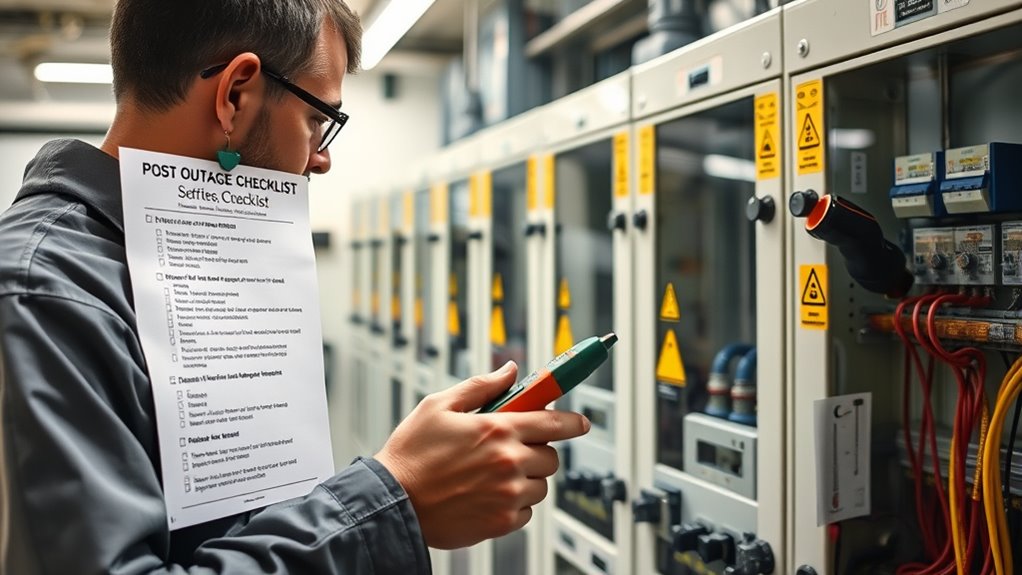
Just because your electrical devices powered back on doesn’t mean they’re safe to use right away. Electrical safety is vital after an outage, as damage might not be immediately visible. You need to perform a thorough equipment inspection before resuming normal use. Look for signs of damage such as frayed cords, scorch marks, or burning smells. Avoid plugging in or turning on devices that show any signs of damage. Remember, electrical components can be compromised even if they appear intact, posing fire or shock hazards. Never assume equipment is safe solely based on functionality. Proper inspection guarantees safety and prevents further damage or injury. Take the time to verify each device’s condition before restoring power, safeguarding both your home and everyone in it. Incorporating somatic safety practices can also help you stay alert to physical sensations indicating electrical or environmental hazards.
Overlooking the Need to Inspect and Reset Circuit Breakers Properly

Even if your circuit breakers trip during a power outage, it’s vital not to assume they’re ready to reset without inspection. Proper circuit breaker inspection is essential to ensure they function correctly and haven’t sustained damage. Before resetting, check for signs of burn marks, corrosion, or wear. Follow the correct reset procedures: turn off the breaker fully, wait a moment, then switch it back on firmly. Avoid rushing the process, as improper resets can cause further issues or electrical hazards. Remember, a breaker that trips repeatedly may indicate underlying problems needing professional attention. Taking the time to inspect and follow proper reset procedures helps prevent future outages and keeps your electrical system safe and reliable. Never skip these steps, even if power appears restored. Regularly assessing and maintaining your electrical components can help identify issues early and ensure ongoing safety.
Neglecting to Test and Reset GFCI Outlets Before Use
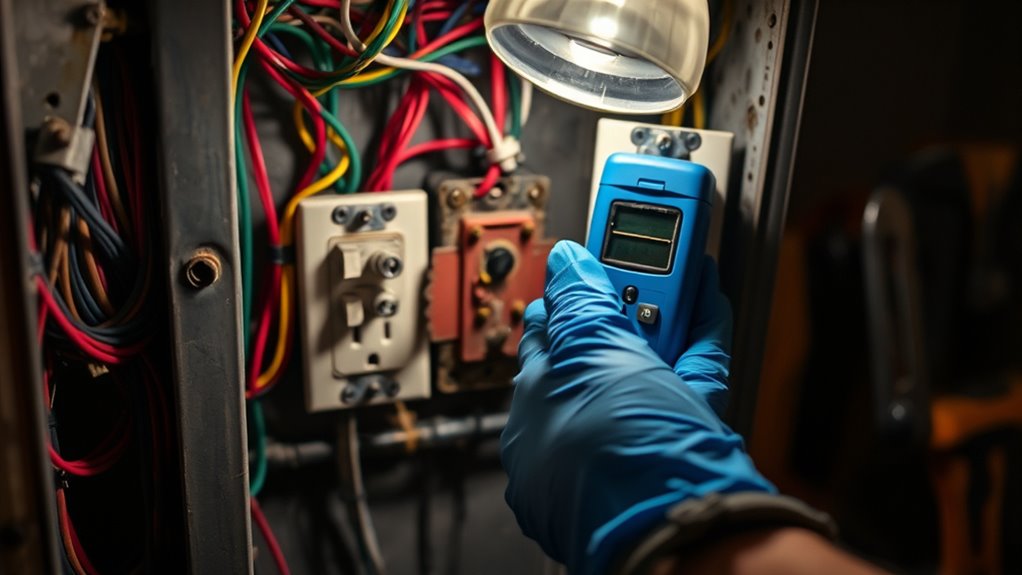
Before plugging anything back in, make sure your GFCI outlets are properly reset. Test each one to confirm they’re functioning correctly, and don’t reuse them immediately without verification. Skipping these steps can lead to electrical hazards or equipment damage. Additionally, verifying the outlet’s proper functioning ensures safety and prevents potential malfunctions.
Confirm GFCI Reset Properly
To make certain your GFCI outlets are functioning correctly after a power outage, it’s essential to verify they’re reset properly before using them. Failing to do so can lead to shock hazards or device malfunctions. During GFCI troubleshooting, ensure the outlet’s reset button is fully pressed and engaged. Here are key steps to confirm proper reset:
- Check that the indicator light (if present) is on, signaling power flow
- Press the reset button firmly until it clicks
- Avoid partial presses or loose connections
- Perform GFCI testing to verify correct operation before plugging in devices
- Remember that GFCI technology is designed to prevent electrical shocks by shutting off power during ground faults, so proper reset is crucial for safety.
Test GFCI Functionality
Failing to test your GFCI outlets after resetting them can leave you unaware of whether they’re functioning properly, which increases the risk of electrical shock or damage to connected devices. Always remember to test GFCI functionality before using outlets after an outage. To do this safely, follow basic safety precautions: keep your hands dry, avoid touching metal parts, and ensure the power is off if needed. Press the “Test” button on the GFCI, then press “Reset” to restore power. If the outlet trips or doesn’t reset properly, do not use it until it’s inspected or replaced. Testing GFCI outlets is a simple yet vital step to confirm they’re working correctly, providing essential protection from electrical hazards after a power outage. Regularly performing these tests can also help identify malfunctions early, ensuring continued safety and functionality.
Avoid Immediate Reuse
Neglecting to test and reset GFCI outlets before using them after a power outage can expose you to unnecessary electrical hazards. Never assume outlets are safe to reuse without verification. Always press the reset button to guarantee proper operation, especially if you’re planning to power outdoor lighting or connect solar panels. Faulty GFCI outlets can cause shocks or damage connected devices. Before plugging in outdoor lighting or reconnecting solar panels, check all GFCIs in the affected area. Remember:
- Test GFCIs before use
- Reset if they trip
- Verify outdoor lighting functions properly
- Ensure solar panels are safely connected
Taking these steps helps prevent electrical accidents and ensures your equipment operates safely after an outage. Don’t risk safety—always test and reset GFCI outlets first.
Failing to Discard Spoiled Food and Water Supplies Promptly

If spoiled food and contaminated water are not discarded promptly after a power outage, they can pose serious health risks. Spoiled food may harbor bacteria and toxins that cause food poisoning, while contaminated water can lead to infections. Prioritize food safety by checking expiration dates and discarding anything that smells or looks off. Water preservation is also essential; water stored during the outage might be unsafe to drink if it’s been compromised. Don’t hesitate to throw out perishable items that have been stored beyond safe timeframes. Keeping your food and water supplies clean and safe prevents illness and ensures your recovery goes smoothly. Acting quickly helps reduce health hazards and safeguards your family’s well-being in the aftermath of a power outage.
Underestimating the Importance of Ventilation During Power Restoration
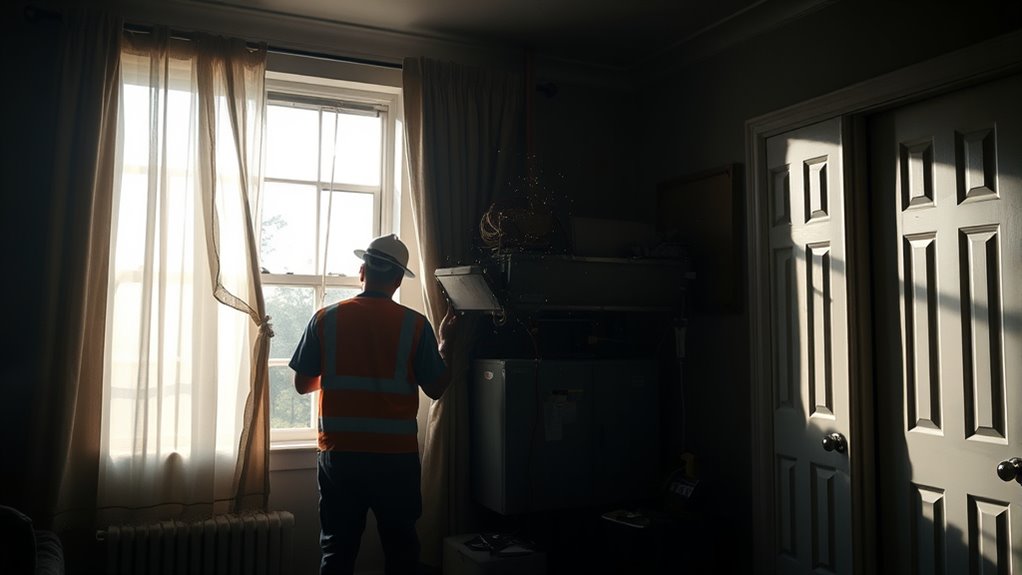
Proper ventilation is vital when restoring power, as it helps maintain good indoor air quality. Without enough airflow, stale air and pollutants can build up quickly. Ensuring adequate ventilation also prevents mold from forming on damp surfaces.
Ensuring Indoor Air Quality
Have you considered how crucial ventilation is when restoring power indoors? Good airflow helps remove indoor pollutants and keeps air fresh. During power restoration, stagnant air can trap dust, fumes, and bacteria, reducing indoor air quality. To improve it, consider:
- Opening windows and doors regularly
- Using fans to circulate air effectively
- Placing indoor plants that naturally purify air
- Maintaining air purification devices to filter contaminants
These steps help eliminate indoor pollutants and support healthier breathing. Proper ventilation is essential for reducing airborne irritants and preventing indoor air from becoming stale or contaminated. Indoor plants not only add aesthetic value but also act as natural air purifiers, improving overall air quality. Don’t underestimate the power of fresh air—it’s key to a safe, healthy home during post-outage recovery.
Preventing Mold Growth
Neglecting ventilation during power restoration can quickly lead to mold growth, which often goes unnoticed until it causes significant damage. Proper ventilation is essential for mold prevention because it helps control moisture levels that fuel mold spores. Without adequate airflow, humidity can rise inside your home, providing the perfect environment for mold to thrive. To prevent this, open windows and use fans to promote moisture control, especially in areas prone to dampness like bathrooms and basements. Keep indoor humidity below 60%, ideally around 30-50%. Regularly check for condensation or damp spots, and dry out any wet surfaces immediately. Good ventilation isn’t just about comfort—it’s your first line of defense against mold growth after a power outage.
Rushing to Turn Everything Back On Without a Systematic Approach

Rushing to turn everything back on without a systematic approach can lead to overlooked issues and further complications. You might miss critical checks, risking safety and equipment damage. Before restoring power, verify emergency lighting functions properly, as it’s essential during outages. Make certain appliances are calibrated correctly to prevent malfunctions or hazards. Skipping these steps can cause costly mistakes down the line.
Remember to:
- Test emergency lighting systems for proper operation
- Confirm all safety devices are reset and functional
- Check for loose connections or damaged wiring
- Follow a logical sequence to power on equipment and systems
Taking your time ensures a safer, more reliable recovery, preventing small problems from escalating into bigger outages or safety hazards.
Ignoring the Need for a Backup Power Plan Before an Outage Occurs

Failing to develop a backup power plan before an outage can leave your operations vulnerable when the power goes out unexpectedly. Without a plan, you risk delays, damage, or data loss. Prioritize generator safety by ensuring proper installation and routine maintenance, so your backup system works effectively when needed. A battery backup can be a quick solution for essential devices, keeping critical systems running without the noise and fumes of generators. However, relying solely on battery backups isn’t enough for long outages. Planning ahead allows you to choose the right combination of backup power sources, understand their limits, and prevent accidents caused by improper generator use. Don’t wait until an outage strikes—prepare now to keep your operations safe and resilient.
Forgetting to Communicate With Family or Neighbors About the Situation

Since power outages can last longer than expected, maintaining communication with your family and neighbors about the situation is vital. Clear communication boosts community awareness and helps coordinate responses. If you neglect this, you risk misunderstandings and missed opportunities for support. To guarantee effective neighbor coordination, consider sharing updates regularly. Keep everyone informed about:
- The outage’s expected duration
- Any safety concerns or hazards
- Available resources or assistance
- Emergency contact information
Overlooking the Need to Replenish Essential Supplies After Power Returns

After power is restored, it’s easy to overlook the importance of replenishing essential supplies that may have been depleted during the outage. Good supply management is vital for emergency preparedness, ensuring you’re ready for any future disruptions. Make a quick inventory of needed items like bottled water, non-perishable food, batteries, and medications. Use this simple chart to guide your replenishment:
| Item | Quantity Needed | Priority |
|---|---|---|
| Bottled Water | Restock to full | High |
| Batteries | Replace as needed | Medium |
| Medications | Ensure expiry date | High |
Neglecting this step can leave you unprepared when the next emergency hits. Regularly check and replenish supplies to stay ahead.
Underestimating the Risks of Using Damaged or Old Wiring
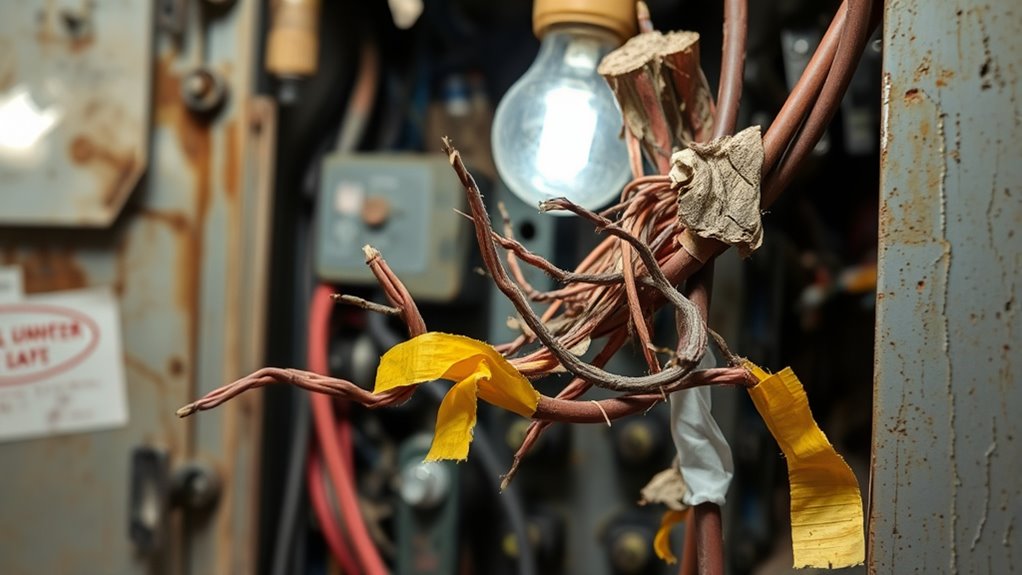
Using damaged or old wiring can markedly increase your risk of electrical fires, shocks, and equipment damage. After a power outage, don’t skip a thorough wiring inspection. Old or damaged wiring often appears fine but can hide serious hazards. Conducting a proper risk assessment helps identify hidden issues before restoring full power. Ignoring these signs can lead to dangerous situations. Be alert to these warning signs:
- Frayed or cracked insulation
- Burn marks or melting
- Loose or exposed wires
- Unusual odors near outlets
Believing That Power Restoration Means All Systems Are Fully Functional

Just because the power is back on doesn’t mean all your systems are working perfectly. You might assume everything is operational, but some equipment could still be malfunctioning or partially damaged. Always verify system performance before resuming normal operations to avoid unexpected failures.
Assumes Immediate Full Power
While power may appear fully restored on the surface, it’s a common mistake to assume all systems are operational immediately. Restoring power doesn’t guarantee everything is functioning properly. You might need to check generator maintenance to ensure your backup sources are ready, especially if you rely on a generator during outages. Outdoor lighting systems may come back on, but they might not operate correctly or safely.
Before assuming full functionality, verify that:
- Critical systems are running smoothly
- Backup generators are working properly
- Outdoor lighting is fully operational
- No lingering electrical issues remain
Jumping to conclusions can cause further damage or safety hazards. Take time to methodically test each component before resuming normal operations.
Overlooks System Checks
Even if the power appears fully restored, assuming all systems are operational can lead to overlooked issues. Power restoration doesn’t guarantee system health or that software updates completed correctly. Critical components like servers, network devices, and security systems may still be vulnerable or malfunctioning. Skipping thorough checks can cause delays later on and risk data loss or security breaches. Use this quick checklist to ensure everything’s in order:
| Check | Why It Matters |
|---|---|
| System health status | Detect hidden malfunctions |
| Software updates | Ensure security and stability |
| Hardware connections | Prevent connectivity issues |
| Backup system status | Confirm data integrity |
Always verify these elements to ensure your systems are truly ready for normal operation.
Failing to Review and Update Emergency Plans Based on Recent Experience
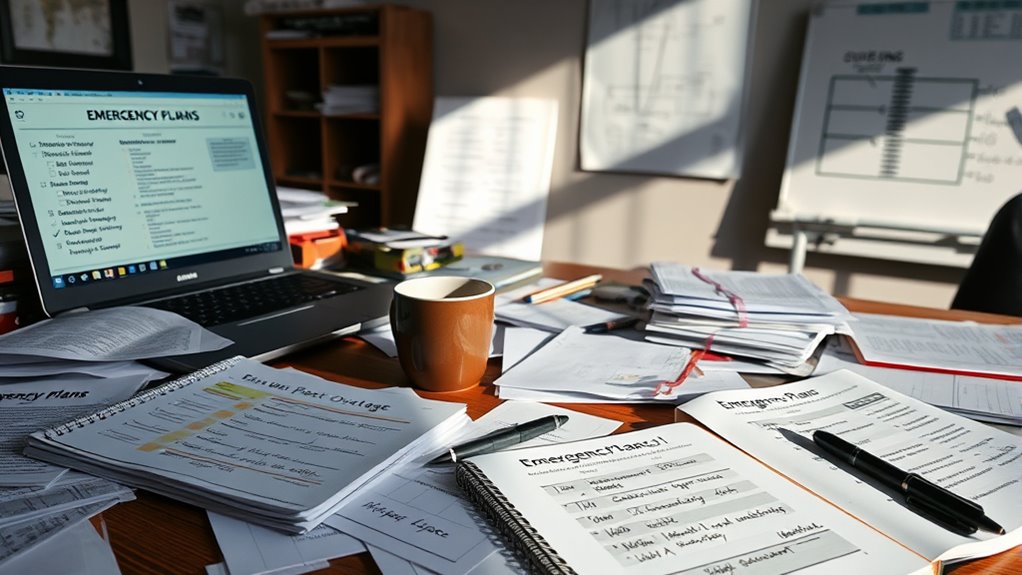
Failing to review and update emergency plans after a recent outage can leave your organization vulnerable to repeating mistakes and missing critical improvements. Post-outage, it’s essential to analyze what went wrong and adapt your plans accordingly. Regularly conducting emergency drills helps identify gaps, while updating communication plans ensures everyone stays informed during crises. Neglecting these steps can lead to ineffective responses and increased downtime. To prevent this:
Regularly review and update emergency plans to prevent repeated mistakes and improve response effectiveness.
- Revise procedures based on recent experiences
- Adjust communication plans for clarity and speed
- Incorporate lessons learned from emergency drills
- Ensure all team members are trained on updated protocols
Frequently Asked Questions
How Can I Tell if My Home’s Wiring Is Safe After an Outage?
You can start by doing DIY inspections of your home’s wiring, looking for signs like frayed cords, scorch marks, or burning smells. Test your outlets with a voltage tester to make certain they’re working correctly. If anything seems off, don’t hesitate to call a licensed electrician. Prioritizing electrical safety protects your home and loved ones, so always err on the side of caution and get professional help when needed.
What Are Signs That Structural Damage Occurred During the Power Outage?
You might notice signs of structural damage after an outage if you see cracks in walls or ceilings, which could result from power surges or electrical stress. Electrical smells or burning odors are also red flags, indicating potential wiring issues that could have caused damage. Keep an eye out for unusual sounds or slight shifts in your home’s framing, and if you spot any of these, consult a professional to assess the damage properly.
When Should I Replace or Repair Damaged Appliances After an Outage?
You should schedule an appliance inspection immediately after a power outage if you notice any unusual sounds, smells, or performance issues. For repair timing, wait until a qualified technician confirms the appliance is safe to use again, especially if there’s visible damage or suspected electrical problems. Don’t delay; timely inspection and repair help prevent further damage and guarantee your appliances operate safely and efficiently.
How Often Should I Review and Update My Emergency Recovery Plan?
“An ounce of prevention is worth a pound of cure.” You should review and update your emergency recovery plan at least once a year, or after significant changes in your home or family situation. Incorporate maintenance scheduling into your plan review frequency to guarantee everything stays current. Regular check-ins help you stay prepared, identify weaknesses, and adapt to new challenges, keeping your safety and readiness sharp as a knife.
What Are the Best Practices for Communicating With Neighbors During an Outage?
During an outage, you should prioritize clear neighbor communication by sharing outage notifications promptly. Use multiple channels like phone calls, texts, or social media to guarantee everyone stays informed. Keep neighbors updated on the outage’s status and estimated repair times. Be respectful, concise, and responsive, encouraging them to share their concerns or additional information. Effective neighbor communication helps foster community support and reduces confusion during post-outage recovery efforts.
Conclusion
Just like tending a garden after a storm, your post-outage recovery needs patience and careful attention. Don’t assume everything’s back to normal or rush into using appliances. Take time to check for hazards, update your plans, and guarantee safety first. By doing so, you’ll keep your home secure and your family protected, turning a chaotic outage into a manageable recovery—like planting seeds for a safer, brighter tomorrow.
